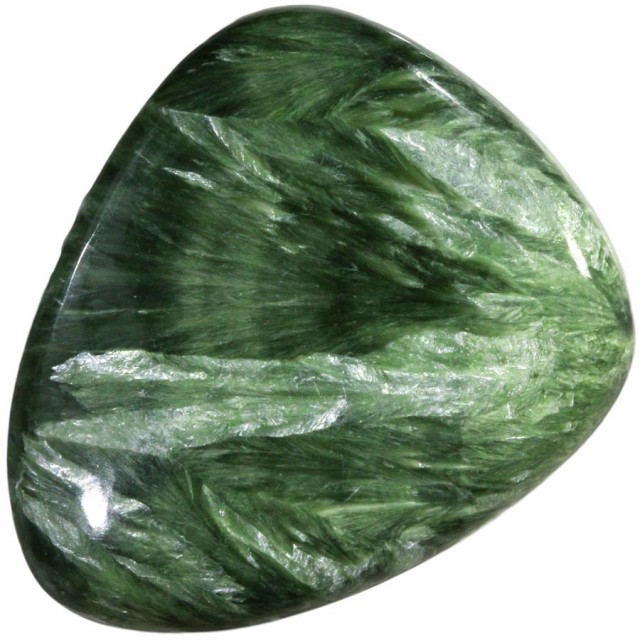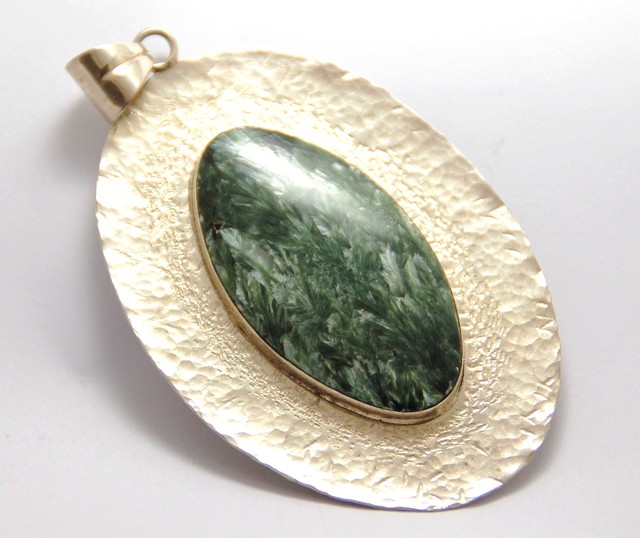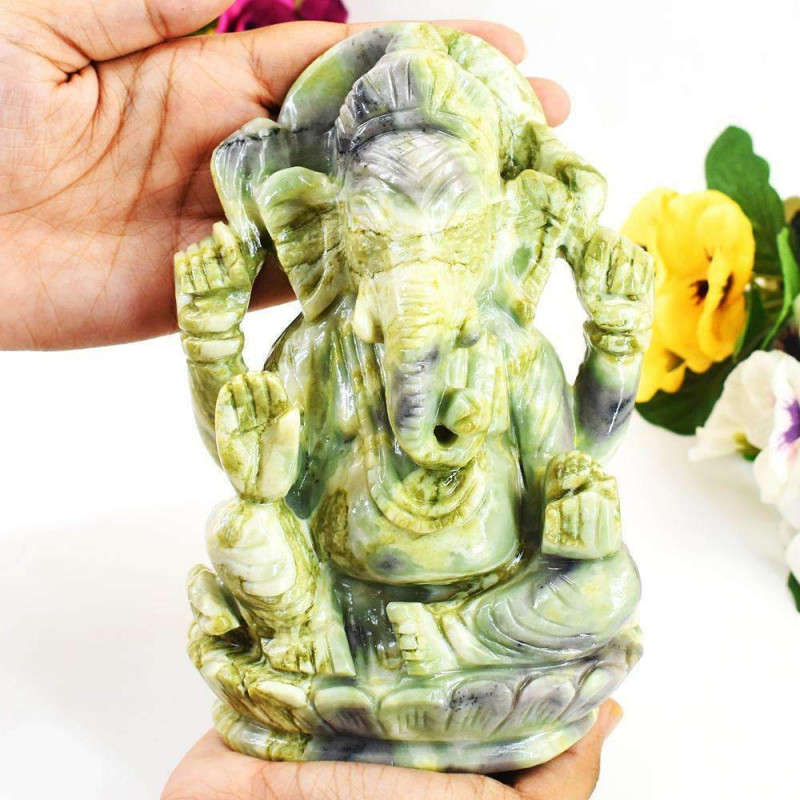
Seraphinite Gemstone: Properties, Meanings, Value & More
 Seraphinite (sair-uh-FEEN-ite) is a dense, fine-grained gemstone variety of clinochlore and belongs to the chlorite group. Often called green chlorite, it’s typically a deep forest green with silvery, feather-like additions of mica. Rarely, it can appear in variations of red, yellow, gold, or black.
Seraphinite (sair-uh-FEEN-ite) is a dense, fine-grained gemstone variety of clinochlore and belongs to the chlorite group. Often called green chlorite, it’s typically a deep forest green with silvery, feather-like additions of mica. Rarely, it can appear in variations of red, yellow, gold, or black.
Seraphinite stone’s name derives from the Greek word seraphim, meaning “winged heavenly being,” because of its iridescent, feather-like fibers. The fibers have a likeness to silver, feathery wings flying within a gem of deep forest green. That’s why seraphinite stone meanings are so deeply tied to the celestials — but more on that later!
Is seraphinite a crystal? Yes! It’s one of the best crystals for meditation, making it highly sought-after in spiritual circles. Is seraphinite rare? Gem-quality seraphinite is found exclusively in the Lake Baikal region of Siberia, Russia, so it's extremely rare!
Excited to learn more about this angelic stone? Today, we’ll break down all of the seraphinite meanings, uses, properties, and more!

About Seraphinite Stone
Seraphinite is a unique and beautiful semi-precious gemstone. Because of seraphinite gemstone hardness, or lack thereof, it’s not necessarily considered a jewelry stone but more so a collector’s stone.
That’s not to say that seraphinite jewelry doesn’t exist. It just means that jewelry-makers must use special care when working with this delicate gem.
While it isn’t an official zodiac stone, seraphinite is closely associated with Sagittarius. As truth-seekers, Sagittariuses can use seraphinite to help in linking the physical with the divine, opening the door for powerful communication with celestial realms. Seraphinite’s feminine energies also bring balance to Sagittarius’ masculine energies.
Is there another name for seraphinite? Actually, there are a few! It’s commonly referred to as serafine, serafinite, serafina, green clinochlore, or chlorite jade (because of its green hues). Seraphinite is also nicknamed the “Stone of Angels” for its powerful spiritual energy.
So what does seraphinite look like?

Seraphinite Specifications & Characteristics
Seraphinite is usually a dark, forest green color closely resembling emerald. It’s typically opaque with areas of translucence, which allows for light to refract beautifully through the silvery, feather-like mica inclusions.
The stone’s refractive index is similar to that of emerald and aquamarine. Like all chlorites, seraphinite presents perfect cleavage in one direction. However, unlike most chlorites with a triclinic crystal system, seraphinite is monoclinic.
When polished, the gem displays a pearly to vitreous luster. It’s a relatively soft and delicate gem with a density similar to quartz or beryl.
Here’s an overview of seraphinite crystal properties:
Formula: Mg5 Al(AlSi3 O10)(OH)8
Mineral Family: Phyllosilicates – Clinochlore (Chlorite group)
Composition: Aluminosilicate of magnesium and iron
Mohs hardness: 2-2.5
Colors: Various shades of green, rarely yellow, gold, red, black & white
Crystal structure: Monoclinic with some Triclinic polymorphs
Luster: Pearly, vitreous, greasy, dull
Transparency: Translucent to opaque
Refractive index: 1.571 - 1.599
Specific Gravity: 2.60 - 3.02
Cleavage: Perfect - 001 (in one direction)
Fracture: Lamellar
Streak: Greenish-white or white
Fluorescence: None

Seraphinite Meaning & History
Russian mineralogist Nikolay Ivanovich Koksharov is credited with discovering seraphinite near Lake Baikal in Siberia. Estimated to be approximately 20-25 million years old, Lake Baikal is the oldest existing freshwater lake in the world. Many of the lake’s lifeforms only exist there.
In 1851, seraphinite specimens were found in West Chester, Pennsylvania. Since then, other places across the U.S. have uncovered seraphinite as well. While other countries, including Europe, have also identified seraphinite, the primary deposits remain near Lake Baikal.
“Seraphinite” is actually a trade name for a specific form of silicate mineral called a clinochlore. Clinochlore’s name is derived from the Greek word chloros meaning "green," after the stone’s base color, not chemical makeup.
Seraphinite, along with other green crystals, honors the Greek goddess of spring, Persephone. She represents celebration and new growth.
In Christianity, seraphinite’s long, silvery, feather-like filaments are believed to evoke the Seraph, a biblical creature with an important place in the heavens. The Seraph has three pairs of wings and is an angel of high hierarchy in religious texts. The Bible often refers to Seraphs as accompanying God’s throne and heavenly chariot within the Book of Isaiah.
Now let’s explore seraphinite’s metaphysical properties!

Seraphinite Healing Properties
With a nickname like “Stone of Angels,” seraphinite has quite the reputation to live up to! Indeed, it’s believed to be one of the strongest healing stones. Plus, its powerful energy is said to be felt by simply touching it!
Like all clinochlore, seraphinite gemstone benefits growth and support in all aspects of life: physical, emotional, and spiritual.
Keep reading to learn how seraphinite healing properties can elevate your mind, body, and soul!
Physical Healing
What is seraphinite crystal good for physically?
This gem’s energy is believed to aid the heart, lungs, and cellular regeneration. It can support cellular respiration and nutrient delivery. It may also help with the prevention and shrinking of cancer cells.
Seraphinite crystal is said to help detox and strengthen the liver and kidneys. It can stimulate metabolism and aid in weight loss. It’s also believed to help activate the spinal cord.
Fancy a massage? Seraphinite could help release muscle tension!
Emotional Healing
What is seraphinite stone good for emotionally?
As the “Stone of Angels,” it’s believed to possess immense spiritual energy bringing the physical self into harmony with the emotional self.
Crystal healers use seraphinite to stabilize the spirit and bring peace to daily life. It’s said to aid in releasing emotional patterns and attachments that no longer serve you. Seraphinite is also said to produce joyful, enlightened energy.
This crystal’s ties to growth are associated with tenderness and care in emotional healing. It defines a sense of order amidst chaos, lending the understanding that you are neither helpless nor hopeless in creating or correcting one’s own reality.
Have some bridges that need mending? Wearing a seraphinite ring or necklace may help enhance social skills and promote reconciliation!

Chakra Healing
Chakras are energy points along the center of your body. When a chakra falls out of balance, some gems are used as chakra stones to shift you back into alignment.
What chakra is seraphinite associated with? Technically, all of them! Seraphinite is believed to invite the Kundalini, which helps clear and stimulate every chakra. However, seraphinite is especially attuned to your heart chakra.
The heart chakra, or Anahata, is responsible for governing decision-making, emotions, and of course, love. Why is this the seraphinite chakra? Similar to how it’s believed to support the physical heart, seraphinite does the same for the chakral heart with its vibrations of wholeness, nurturing, and unconditional love.
Spiritual Healing & Balancing Energy
What does seraphinite do spiritually?
Seraphinite is a vessel of light energy! It helps you understand the nature of physicality as it brings heavenly light into the body, expressing it through you as glowing health.
This gem’s high vibrations allow out-of-body experiences to self-reflect and identify changes for fulfillment and peace. It’s also believed to protect the physical body while astral traveling.
Seraphinite spiritual properties may also provide balancing energy in Feng Shui, the spiritual practice of directing energy through configuring a space.
Seraphinite brings wood energy (associated with growth, development, health, and vitality). It can be placed in Northeast areas for self-cultivation, Southwest for supporting relationships, and any area for dispelling negative energy.
This gem’s most abundant hue is green, but can seraphinite change colors?
Types of Seraphinite
While the green seraphinite gemstone is the most common variety, it can appear in other shades — such as blackish-green, yellowish-green, bluish-green, tan, white, brown, red, yellow, and olive. Like all crystals, seraphinite properties and meanings vary depending on their color.
Black Seraphinite

Like its green counterpart, black seraphinite is believed to facilitate communication with the astral realms. Black seraphinite properties are said to be a source of protective energy, similar to other black gemstones. Ancients even wore it as a protective amulet against snakebites!
Red Seraphinite
![34.49 CTS GOLDEN SERAPHINITE -RUSSIA [ST7575]](https://df2sm3urulav.cloudfront.net/tenants/gr/uploads/images/345000-349999/349388/349388_1363655700.jpg)
Red seraphinite is extremely rare. Like most red gems, it has a warm and passionate energy said to bring motivation and vitality. What is the red in seraphinite? It could be a result of the contained chromium.
So what is seraphinite made of, and where does it come from?
Seraphinite Formation & Sources
While seraphinite is a member of the chloride family, it doesn’t actually contain chlorine. Seraphinite is a variety of clinochlore, a chlorite mineral that forms through metamorphic and hydrothermal alterations of iron and magnesium silicates in Earth’s crust.
So, where do you find seraphinite today?

Mining Locations
Russian seraphinite gemstones can only be found in… you guessed it, Russia! It’s mined in a remote area near Lake Baikal. More specifically, an iron deposit near Korshunovskoye, a region in present-day Eastern Siberia. The deposit is apparently so remote, miners have to keep an eye out for Siberian tigers on the prowl!
Some seraphinite crystals have also been identified in other localities around the world:
Turkey
Austria
Switzerland
Italy
United States
Now that we know where it comes from, let’s see how seraphinite value is determined.

Seraphinite Gemstone Properties & Value
Their rarity makes seraphinite a highly sought-after and valued gemstone, but affordable specimens are also available.
Some of the factors that determine its value are:
Color
Seraphinite is typically dark-green to gray with silvery chatoyant fibers. These fibers form patterns similar to feathers — hence, its association with angel wings! These silvery mica inclusions may be sparsely or densely distributed throughout the crystal.
Rarely, seraphinite appears in various shades of red, yellow, gold, or black. The obscurity of these shades tends to earn them a higher value.
Cut
Seraphinite’s softness limits its uses in jewelry. However, seraphinite gemstone cabochon cuts have been set into low-wear jewels such as pendants. It’s also sold uncut (rough), polished, and in fancier, faceted cuts or unique carvings. If cut correctly, seraphinite can exhibit a cat’s eye effect.

Clarity
Seraphinite stones are translucent to opaque. Its translucence is present on the silver mica inclusions, which exhibit chatoyancy. Its luster can be pearly, vitreous, greasy, or dull.
Treatments
Occasionally, seraphinite is polymer impregnated to make it more durable. However, untreated gemstones are available, and most crystal traders declare treatments or enhancements.
How can you tell if seraphinite is real? Look for strong, sharp crystal patterns and the chatoyancy effect. Seraphinite loose gemstones that are inauthentic are usually made from agate, howlite, or magnesite and won’t exhibit this unique seraphinite trait!
So how do seraphinite gemstone properties fare in terms of value?
Rough, untreated seraphinite costs about $1.08 per carat, while polished specimens start at approximately $4.50 per carat. Cabochon cuts start at about $6.00 per carat. Generally, seraphinite gemstone prices range from about $10—$200 overall.
Due to its softness, seraphinite is mainly a collector's stone and not as sought-after by lapidaries as other gems. However, it’s still a popular crystal for jewelry and carvings. Because it rarely exists beyond a few remote deposits and is relatively new in Western Europe, it tends to be costlier than other semi-precious gems.
So how do you take care of your seraphinite crystals?

Seraphinite Care and Maintenance
Due to its softness, seraphinite requires special attention when caring for gemstones.
Take extra caution to avoid:
Heat
Pressure
Chemicals
Acids
Sweat
Do not wear it while swimming, playing sports, or partaking in activities that might scratch the delicate gem. Store seraphinite in a fabric-lined box away from other, harder gemstones and materials.
Is seraphinite okay in water? Absolutely! To clean seraphinite, use lukewarm water and a soft cloth. You can also use a mild detergent, but avoid any with citrus. Carefully rinse your seraphinite stones to remove any residue. Then, gently pat the stone dry.
Get Carried Away with Seraphinite!
Seraphinite stones are divine gems — not just for their appearance resembling heavenly angel wings, but also for their literal ties to the celestials!
Let seraphinite carry you away and help you reconnect with your higher power!
Search the Gemstone Encyclopedia
Related Auctions
Related Articles
Originally the Birthstones or gemstones were associated with a zodiac sign or the month of a individuals birth. Find out what your stone is and view the stones we have for sale
8th Feb 2021
There are dozens of quartz and chalcedony gems with various colors and patterns. Learn all about quartz properties and every type of quartz, from amethyst and agate to plasma and phantom quartz!
15th Oct 2020
Hackmanite is a pink to violet sodalite gem known for its unique color-change and luminescence. Learn why hackmanite is special, from its rare qualities to the types of hackmanite jewelry available.
28th Mar 2018
Latest Articles
Stibiotantalite is a rare tantalum mineral sometimes found as stunning yellow to orange gems. Discover the history, properties, prices, and uses of stibiotantalite gemstones in this complete guide.
21st Jan 2025
Milarite is a white, green, or yellow beryllium silicate in the milarite-osumilite group. Faceted gems are rare but stunning. Discover the history, properties, prices, and benefits of milarite gems!
6th Jan 2025
Friedelite is an uncommon pink, red, or brown manganese silicate mineral best known from New Jersey and South Africa. Learn the prices, properties, uses, and history of friedelite gemstones.
23rd Dec 2024
Article Categories
How To's is where you will find helpful articles from gem Rock Auctions on how to cut gemstones, select gemstones and buy gemstones.
9 Articles





